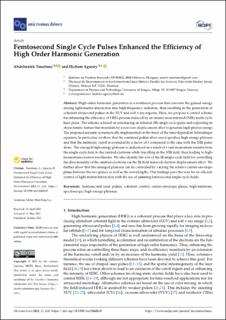Femtosecond Single Cycle Pulses Enhanced the Efficiency of High Order Harmonic Generation
Journal article, Peer reviewed
Published version

Åpne
Permanent lenke
https://hdl.handle.net/11250/2985609Utgivelsesdato
2021Metadata
Vis full innførselSamlinger
Sammendrag
High-order harmonic generation is a nonlinear process that converts the gained energy during light-matter interaction into high-frequency radiation, thus resulting in the generation of coherent attosecond pulses in the XUV and soft x-ray regions. Here, we propose a control scheme for enhancing the efficiency of HHG process induced by an intense near-infrared (NIR) multi-cycle laser pulse. The scheme is based on introducing an infrared (IR) single-cycle pulse and exploiting its characteristic feature that manifests by a non-zero displacement effect to generate high-photon energy. The proposed scenario is numerically implemented on the basis of the time-dependent Schrödinger equation. In particular, we show that the combined pulses allow one to produce high-energy plateaus and that the harmonic cutoff is extended by a factor of 3 compared to the case with the NIR pulse alone. The emerged high-energy plateaus is understood as a result of a vast momentum transfer from the single-cycle field to the ionized electrons while travelling in the NIR field, thus leading to high-momentum electron recollisions. We also identify the role of the IR single-cycle field for controlling the directionality of the emitted electrons via the IR-field induced electron displacement effect. We further show that the emerged plateaus can be controlled by varying the relative carrier-envelope phase between the two pulses as well as the wavelengths. Our findings pave the way for an efficient control of light-matter interaction with the use of assisting femtosecond single-cycle fields.
